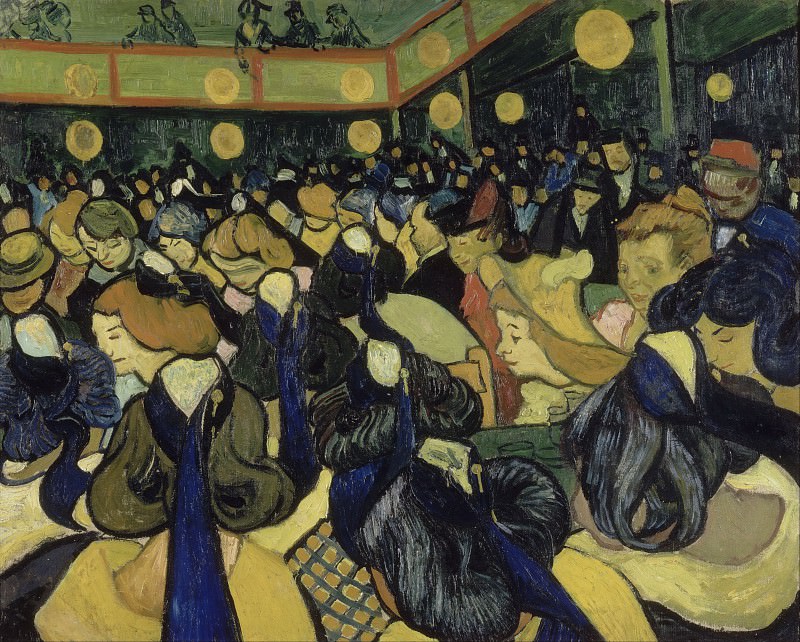Dance Hall in Arles Vincent van Gogh (1853-1890)
Vincent van Gogh – Dance Hall in Arles
Edit attribution
Download full size: 4363×3500 px (5,4 Mb)
Painter: Vincent van Gogh
Location: Orsay Museum (Musée d’Orsay), Paris.
A representative of the current of Post-Impressionism, the artist departs from the concept of instantly conveying a sensual-emotional picture of the world. He tries to convey a profoundly philosophical sense of being. Minor details, rules of the physiological structure of the body and the central figures of the composition become unnecessary. At the forefront of the transfer of information with the help of color spots with the conventional designation of figures and faces.
Description of Vincent van Gogh’s painting "The Dance Hall"
A representative of the current of Post-Impressionism, the artist departs from the concept of instantly conveying a sensual-emotional picture of the world. He tries to convey a profoundly philosophical sense of being. Minor details, rules of the physiological structure of the body and the central figures of the composition become unnecessary.
At the forefront of the transfer of information with the help of color spots with the conventional designation of figures and faces. The main semantic load now is carried by the color and general filling of the picture.
"Dance Hall" fully corresponds to these concepts. The spots of color inside the clear outline resemble stained glass windows. A large gathering of people in a small area is supposed to radiate merriment. After all, this is what all visitors to the hall have come for.
However, the picture reeks of wistfulness and uncertainty. One feels lost in the faceless mass of his kind. The vivid colors of the outfits sound in stark dissonance with the wistful and lost expression on the face of the lady in the yellow hat.
There is not a single clearly defined face, and the visitors appear to be an average crowd with herd instincts. This is emphasized by the color similarity of the outfits and accessories. And the farther into the hall one looks, the more people lose their human face, turning into a random set of colored blots.
The brightness and festivity of the painting are a cover for human longing and loneliness, the impossibility of finding a soul mate among a huge number of people. No one cares who is around and only the tinsel of the holiday hides this fact.
Кому понравилось
Пожалуйста, подождите
На эту операцию может потребоваться несколько секунд.
Информация появится в новом окне,
если открытие новых окон не запрещено в настройках вашего браузера.
You need to login
Для работы с коллекциями – пожалуйста, войдите в аккаунт (open in new window).




















COMMENTS: 1 Ответы
Танцевальный зал в Арле. худ. Ван Гог
Борис Ханин
Какое множество собралось здесь народа.
Зал переполнен, громко музыка звучит.
Для разных типажей и красок здесь свобода,
И это сочетание в холсте бурлит.
При помощи цветных, подчас условных пятен,
Здесь достигается набор фигур и лиц.
Такой прием Ван Гога нам вполне понятен:
Упор на очертанья тел и цвета блиц.
Здесь цветовые пятна в контуре картины
Глядятся в целом, как цветные витражи.
Все в ритме танца эти "витражи" едины.
Все с упоением танцуют типажи.
Но все ж тоской и грустью от картины веет,
И одиночеством от всей толпы людей.
Набор цветных нарядов диссонанс имеет -
Тоскливы лица дам. И, в сущности своей,
Здесь каждому лицу почти совсем нет дела
До того, кто рядом в танце с ним. Мишура
У праздника скрывает этот факт умело.
В цветной толпе у каждого – своя судьба.
You cannot comment Why?
The painting Dance Hall in Arles by Vincent van Gogh depicts a crowded and lively scene within an indoor venue, presumably a dance hall or a public gathering space. The canvas is filled with numerous figures, rendered in bold strokes and vibrant colors typical of Van Goghs style.
We see a dense assembly of people, their forms suggested rather than meticulously detailed. Many figures are seated, facing inwards, creating a sense of a shared experience. The atmosphere appears festive, with round, yellow lamps suspended from the ceiling casting a warm, ambient glow. The upper section of the painting suggests a balcony or upper level where more spectators are gathered, adding to the sense of a bustling event. The color palette is dominated by earthy tones, greens, yellows, and blues, with touches of red and orange, creating a rich and energetic visual texture.
The subtexts of this painting can be explored through several lenses: